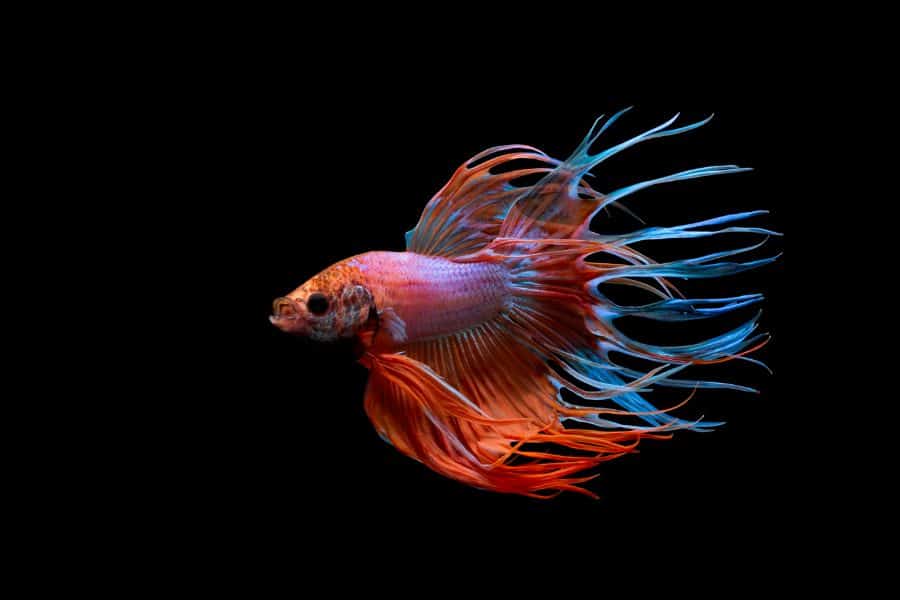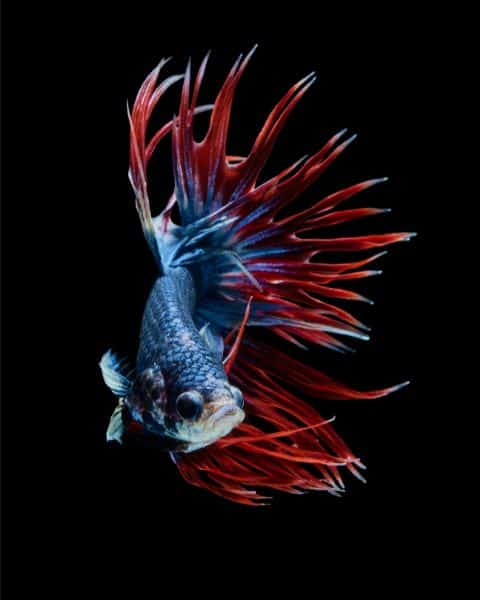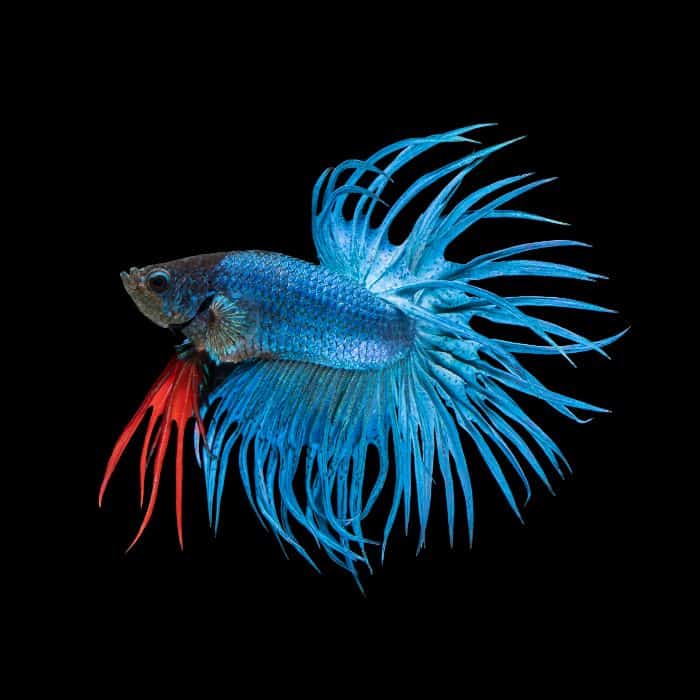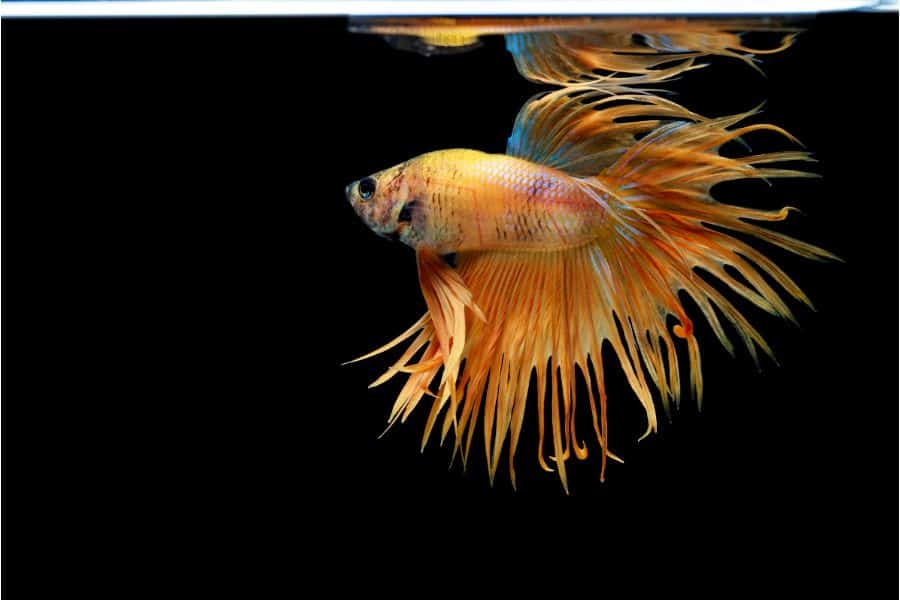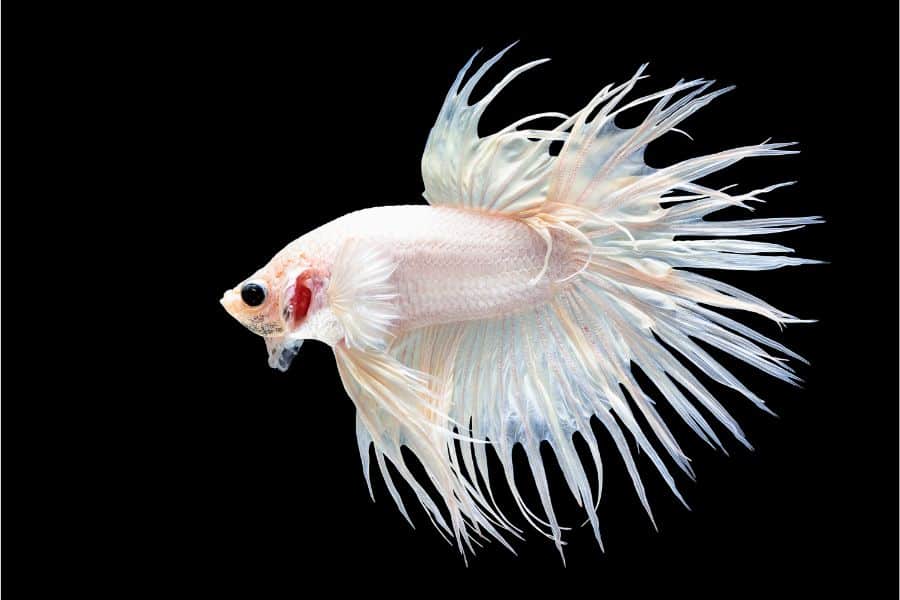The Crowntail Betta Fish is a newer variant of Betta splendens that’s only been around for less than 30 years. However, this variant is quickly rising in popularity in recent years, and it’s not difficult to see why.
In this article, we’ll talk about the Crowntail Betta, an incredible Betta variant that will certainly add a unique flair to your home aquarium.
What Are Crowntail Betta Fish?
| Scientific name | Betta splendens |
| Ease of care | Easy |
| Temperature range | 75 to 82°F (24 to 28°C) |
| Temperament | Aggressive |
| Lifespan | 1 year |
| Size | Up to 3 inches |
| Typical diet | Omnivore but prefers a carnivorous, high-protein diet |
| Minimum tank size | 3-5 gallons |
| Ideal tank size | 5-10 gallons |
| Compatibility | Invertebrates (snails, shrimps), peaceful bottom-dwellers (corydoras catfish), fast swimmers (tetras, rasboras) |
It was in 1997 when an Indonesian breeder named Achmad Yusuf first introduced the “cupang serit,” a variant of Betta fish that he discovered while crossbreeding.
This new variant had fins that looked like spikes, which he noticed was quite different from the normal Betta splendens. The fins had serrations at their tips, with unusually short webbing in between.
(Fun fact: “cupang” is the Indonesian word used to refer to Betta fish. It also means “hickey” or “love bite.” Apparently, Bettas in Indonesia got this name from the old days of fish fighting, when they would leave suck-like marks on their opponent’s skin.)
Over time, Achmad Yusuf’s work was spread through the fish breeding community. Later on, another breeder called Henry Yin showcased his cupang serit at the International Betta Congress (IBC). It was he who came up with the name “Crowntail,” which he got from the crown-like appearance of this variant’s fins.
Henry Yin would also develop other strains of the Crowntail. He’s often credited for the development of the Black Orchid Crowntail, a variant that features spiky black fins with shimmering steel blue in the middle.
Nowadays, Crowntail Bettas are available for purchase at most pet stores or from suppliers that sell freshwater fish. Although they’re still a bit harder to find than Plakats, Veiltails, or Halfmoons, they’re certainly growing in popularity.
Also, just like other types of Betta fish, Crowntails are considered to be some of the most affordable freshwater fish. This makes them a great choice for people who are beginners and don’t want to spend a lot of money to get started.
Crowntail Betta Fish Appearance
Crowntail Betta Fish have an extremely distinct appearance that sets them apart not just from other Betta tail types but from other fish in general.
Crowntails are a long-finned Betta variant. They have long anal and caudal fins, reaching up to thrice the size of their body.
However, unlike other Betta fish, Crowntails don’t have complete webbing present between the rays on their fins. The webbing doesn’t reach the peaks entirely, which creates a sharp, spiky look.
Depending on who you ask, the exact measurement of the webbing needed to qualify as a Crowntail will vary.
For the IBC, only Bettas with webbing that doesn’t exceed 1/3 the length of its fins are considered genuine Crowntails. If it extends beyond 2/3, then it can no longer be categorized as such. Instead, it’s classified as a combtail betta, which is a different type of Betta tail variant.
Crowntail vs. Combtail Betta
Many people get confused about the differences between Crowntail and Combtail Betta. After all, they look extremely similar with their spiky fins.
The difference lies in the length of webbing between their rays. While Crowntails have short, stubby webbing that makes their rays look as spiky as the top of a crown, Combtails have longer webs with dips in between. Due to this, the individual rays aren’t as long as that of a Crowntail.
Crowntail Betta Size
The maximum size of a fully grown Crowntail Betta can reach up to 3 inches in length. Female Bettas tend to be slightly smaller than male ones, but the difference isn’t too drastic. On average, it should only be around 0.5 inches.
However, variations in tank and breeding conditions can affect the size of your fish. Bettas living in poor water quality, for example, can be smaller than those kept in optimal conditions.
Crowntail Betta Colors
Crowntail Bettas come in a whole variety of colors and color combinations. Aside from the shape of their fins, the colors on their body and fins are also typically different. Some even have metallic sheens to them, making them look even more vibrant.
Here are some of the most common variants:
- Red Crowntail Betta Fish
- Blue Crowntail Betta Fish
- Black Crowntail Betta Fish
- White Crowntail Betta Fish
Meanwhile, some of the most sought-after variants include:
- Black Orchid Crowntail Betta Fish
- Steel Blue Crowntail Betta Fish
- Marble Crowntail Betta Fish
- Purple Crowntail Betta Fish
- Rainbow Crowntail Betta Fish
Purple Bettas, in general, can be quite hard to find since not many breeders offer them. This is especially true for Crowntails, which are already less common than other Betta variants.
That said, one of the rarest color variants is the Rainbow Crowntail Betta Fish. Rainbow Crowntails have splotches of color across their body and fins, including varying shades of blue, red, yellow, orange, green, and even purple. These Bettas are usually more expensive than the other color variants due to their rarity.
How to Tell Crowntail Betta Fish Male or Female
Betta fish are dimorphic, which means males of this species have visible differences from females.
The surest way to tell is to check if the Betta has a gravid spot underneath its belly, also known as an egg spot. Only females have this spot, so if your Betta seems to have one, then it’s likely a female.
Aside from this, the main difference has to do with the fin length and coloration. Luckily, Crowntails are some of the easiest Betta variants to differentiate, unlike other variants like Elephant Ear Bettas.
Like other Bettas, male Crowntails are typically more vibrant and colorful than their female counterparts. They also have a slightly longer body and much longer fins, including their pelvic or ventral fins, also known as the beard.
Female Crowntails have longer fins compared to other female Betta variants, but they’re still shorter than a male Crowntail’s. Their fins also have the same spiky look as male Crowntails, although the rays are certainly not as long.
Crowntail Betta Fish Lifespan
So far, this all sounds pretty cool, but how long do Crowntail Betta fish live?
Sadly, Crowntails don’t live very long. The average lifespan of Betta splendens is only around 3 years, and Crowntails are no exception.
If your fish is kept in optimal conditions, then they may live up to 5 years. That said, it’s not uncommon for pet Bettas to pass away between 2-3 years of age.
Crowntail Betta Fish Behavior
Crowntail Bettas can be quite aggressive. Not that this is a surprise, of course, since Bettas have already gained a reputation for being territorial and short-tempered.
You’ll want to watch out for a flaring Crowntail — a ferocious display of aggression that involves spreading their fins and gills wide. This is a sign of them competing with other Bettas, even if they’re the only ones in their tank.
However, like other Bettas, Crowntails do enjoy exploring inside their tanks. They’re curious little animals, always looking out for something to investigate.
So, as long as you provide them with enough interesting stuff, such as caves and hiding spots, they’ll be quite content.
Crowntail Betta Fish Tank Setup
If you want your Crowntail Betta to stay healthy and thriving, it’s important to create a suitable tank environment for them.
Though it may take some effort and research, knowing their basic requirements is the best way to provide a comfortable home for your Crowntail Betta.
Tank Size
The first thing you need to consider is the tank size.
Now, this can be fairly controversial, even among longtime fishkeepers. Some believe that Bettas can survive in 2-3 gallon tanks minimum, while others say that they should be kept in at least 5-10 gallons.
Personally, we recommend getting the biggest tank that you can afford to keep in your home, both in terms of space and budget.
A bigger tank is easier to make stable and maintain, and it also provides your Betta with more room to explore. This is especially important for Crowntail Bettas, as they tend to be more active than other variants and need plenty of swimming space.
Of course, if you want a community tank, it’s best to opt for a 20-gallon-long tank. This gives your Crowntail enough space to establish its territory while also allowing other fish to coexist peacefully.
Water Quality
No matter how big the tank is, you must make sure that it contains clean and filtered water. Tap water is fine as long as you use a trusty water conditioner like Seachem Prime or API Tap Water Conditioner beforehand.
The right water parameters are also important. Crowntail Bettas prefer slightly acidic water, with a pH of around 6.5-7.0 and temperatures between 74-82℉. You should also use a water parameter testing kit like the API Freshwater Master Test Kit to ensure that there’s zero ammonia, nitrates, and nitrites.
Although Crowntails are labyrinth fish, they’ll certainly benefit from an air pump or a bubbler to oxygenate the water. Don’t forget to perform regular water changes in order to keep the tank clean and healthy.
Filter
There are virtually little to no disadvantages to using a filter in your aquarium, as it helps to keep the water clean and safe.
However, some betta keepers opt out of using a filter since Bettas are known to dislike the current created by them. If you’re worried that your Crowntail won’t be able to handle the water flow, then you can always set the filter’s output to a low setting or add some plants and decor around the filter to damper the current.
Lighting
Lighting is very important for Crowntail Bettas. It regulates their sleep cycle, metabolism, and hormones. In terms of wattage, it’s best to go with a low-watt LED option since Bettas don’t require strong lighting. After all, they can tolerate living in murky waters in the wild.
Heater
If you live someplace cold, it’s vital that you buy a heater for your Crowntail Betta fish tank. Crowntails are tropical fish that can’t live in cold water.
A heater will help them keep their metabolism steady and prevents them from getting too stressed out. Just make sure that you buy an adjustable submersible heater and aim for a temperature of 78-80°F.
Substrate and Decorations
Crowntail Bettas love to explore their environment, and having plenty of hiding spots will help them feel more secure.
You can use decorations like rocks, driftwood, plants, and even Betta hammocks to decorate their surroundings. The best aquarium plants include those with broad or long leaves, such as Anubias, Java Ferns, and Hornwort.
When it comes to the substrate, smooth gravel or fine aquarium soil works well with Crowntails, as they don’t like having rough surfaces.
Possible Tankmates
It can be difficult to keep Crowntail Bettas with other fish, but as long as you have the right tank conditions, it’s possible to make it work.
Good tankmates for Crowntails include other peaceful species like:
Bettas can also be kept with fast-moving schooling fish like Ember Tetras or even Harlequin Rasboras – as long as the tank is at least a 20-gallon long tank. This tank size gives both species enough space to establish their own territories and decreases the chances of aggression.
Crowntail Betta Fish Food
Betta fish are mainly carnivores and prefer to eat a variety of live or freeze-dried foods, such as bloodworms, brine shrimp, and daphnia.
You can feed them regular Betta pellets, but make sure to switch it up with tasty treats every now and then. The important thing is that they’re constantly fed with protein sources, as this helps them stay healthy and vibrant.
How Often Should You Feed a Crowntail Betta Fish?
You can feed your Crowntail Betta 2-3 times every day. That said, pay close attention to the amount you’re feeding them each time, as it’s very easy for them to overeat and get impacted.
Start off with 4-5 pieces of pellets, and then add more if your Betta still seems hungry. If, after 2 minutes, they still have leftover food, scoop it out to prevent it from dirtying the tank.
Crowntail Betta Common Diseases
If you want to know how to take care of Crowntail Betta fish properly, you need to know what diseases they’re prone to.
Common Crowntail Betta illnesses include:
- Ich (Ichthyophthirius multifiliis)
- Fin and Tail Rot (columnaris disease)
- Velvet Disease (Oodinium pilularis)
Other common conditions they can suffer from are:
- Overeating
- Constipation
- Impaction
You should also watch out for signs of Betta stress, as this can be just as harmful to them. These signs include lethargy, loss of appetite, and clamped fins. With Crowntails, clamped fins are extremely noticeable. You should take immediate action if you notice any of these symptoms.
Breeding Crowntail Betta
Breeding Crowntail Betta fish can be hard for new breeders because of how aggressive and territorial they can be, even toward their female counterparts.
That said, it’s still completely possible. Here are the steps to breed Betta fish.
- Prepare a breeding tank for your Crowntail Bettas. It should be bare bottom and have a few hiding spots to make the fish more comfortable.
- Get two healthy, compatible Crowntails. They should be at least a year old and longer than 2 inches.
- Ideally, you should’ve already let them become familiar with each other by placing them in two separate clear containers and slowly closing the distance as the days pass.
- After transferring the two fish to the breeding tank, allow them to get close to each other. The male should start building a bubble nest while the female stays nearby.
- Once they’re ready, the male should release his sperm near the female, whose eggs will be fertilized.
- Remove the female from the breeding tank. The male will instinctively want to guard the eggs in the nest. It’s up to you if you want to keep him there or not.
- Regardless, once the eggs hatch in about 3 days, remove the male from the tank to prevent him from eating the young fry.
Also Read:
FAQs
Are Crowntail Bettas Rare?
Crowntail Bettas are a bit rarer than other Betta variants, but they’re certainly getting more and more popular. You can usually purchase them online or at pet stores specializing in aquatic life.
Do Crowntail Bettas Change Color?
Crowntail Bettas don’t technically change color, but they can look a bit different when they’re young. Most young Bettas are duller in color, gradually getting more vibrant as they grow older.
Are Crowntail Bettas Aggressive?
Crowntail Bettas aren’t particularly more aggressive than any other Betta variant. Like other Bettas, they can be territorial and should be kept away from other aggressive fish.
How I Can Tell a Crowntail Betta Fish Female from A Male?
Female Crowntail Bettas have shorter rays and fins than male Crowntails. Additionally, they have a gravid spot, which isn’t present in males.
Conclusion
Crowntail Bettas are a unique and fantastic freshwater fish, making them a great addition to any tank. Like other Betta variants, they’re curious, playful, and can be quite stunning in their own right.
As always, remember to do plenty of research and prepare appropriately before getting your Crowntail Betta. With the right tank setup and dedication, any aquarist, whether new or old, can be successful with this gorgeous Betta variant!
